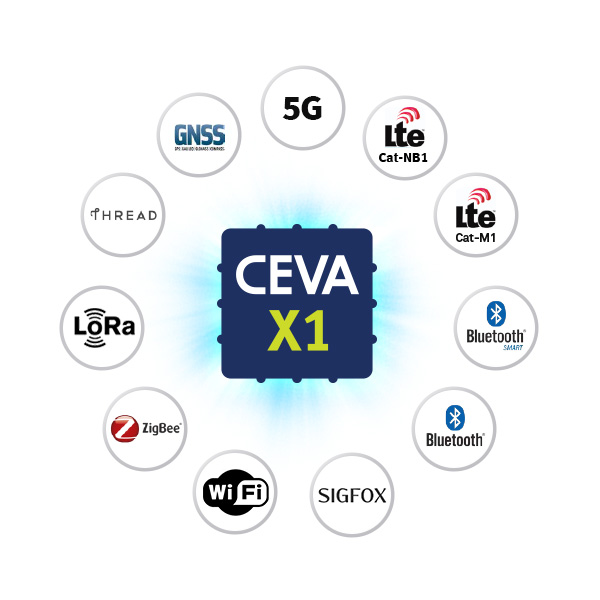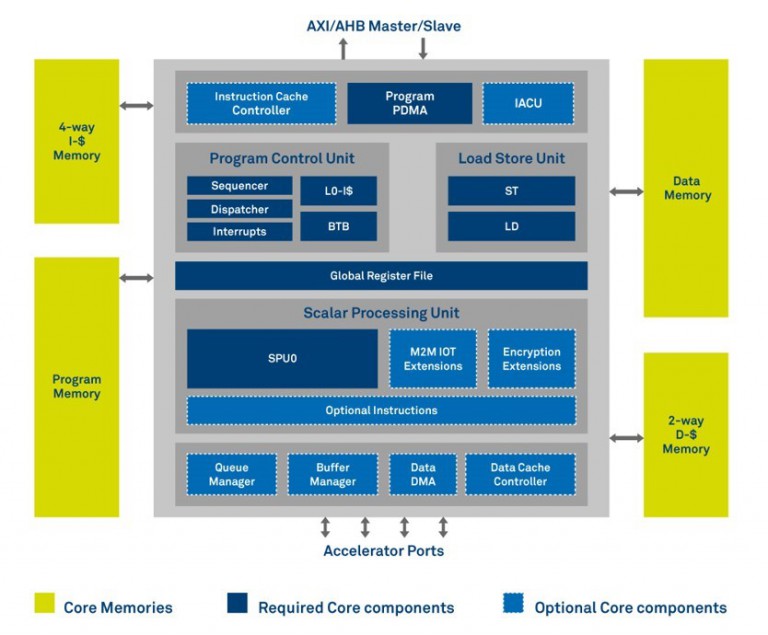Until now there have been some CPUs with DSP capabilities and some DSPs with CPU capabilities available. Some of these are quite common today in various devices. That said, a deeper look at the architecture reveals that there is more to the story. A CPU with DSP capabilities is actually just a CPU with a few added instructions that are typical to DSP, like multiply-accumulate (MAC). These CPUs could never truly compete with a full blown VLIW SIMD DSP in any category of signal processing. The same goes for DSPs with CPU capabilities. They are efficient and perform well, but not well enough to replace a RISC CPU for intensive controller and protocol code. So, in the end, every device gets both. That is, until now.
CEVA-X1 IoT Processor: How Well Does It Perform As a Controller?
Today CEVA announces the CEVA-X1 IoT processor, based on the NEW CEVA-X Architecture Framework which delivers uncompromising performance for both signal processing and controller workloads. Just how well does it perform as a controller? Comparing EEMBC® CoreMark® scores, a commonly used benchmark to measure the performance of CPU processing in embedded systems, the CEVA-X1 CoreMark/MHz score is 3.3 while the ARM® Cortex™-M4 CoreMark/MHz score is 3.4. In other words, it’s on par with the most commonly used CPU for IoT stacks. It also comes equipped with advanced system control for seamless integration with peripherals. Consequently, the CEVA-X1 eliminates the need for an additional CPU, making it the industry’s first single-core architecture that is capable of handling the multitude of IoT scenarios.
A Multi-Purpose Processor for the Diversity of the IoT
The CEVA-X1 IoT processor is specifically designed for the exceptionally rigorous constraints of power and cost limitations of low data rate industrial and consumer IoT use cases. These use cases are widely varied. For example, there are asset trackers used to locate anything from cargo to people and pets for many different ranges from global to local to indoor. Another use case is the wearalone smartwatch that functions either as a standalone device connected directly to the cellular network through LTE Cat-M1 or as a tethered device to a smartphone or home gateway through BLE or Wi-Fi. In parallel to these connectivity modes, the smartwatch might use GNSS to track location together with sensors to monitor vitals and chart fitness achievements. A single CEVA-X1 can handle all these workloads concurrently, running everything in software. Other IoT use cases include the smart home, smart utilities, health, security and environmental, industrial and agricultural monitoring and control.

The CEVA-X1 is uniquely equipped with just the right tools to handle this variety. As a multi-mode processor, it can handle multiple workloads simultaneously, allowing developers complete flexibility to tailor their system to meet the requirements of any IoT use case. Here are the four key components that enable the CEVA-X1 to address this multitude of scenarios:
Connectivity – The CEVA-X1 supports the latest LTE Cat-M1 (formerly eMTC) and Cat-NB1 (formerly NB-IoT) standards as well as future FeMTC and 5G cellular for long range, in addition to short range wireless protocols like Wi-Fi, Bluetooth, BLE, Zigbee/Thread and more.
Positioning – Outdoor positioning using a software approach allows support for all four global navigation satellite systems (GNSS) – GPS, BeiDou, Galileo, and GLONASS. Indoor positioning can be handled with beacons and sensors.
Sensing – Sensor fusion using motion, sound and ambient sensing can be performed simultaneously with other tasks.
Voice – The processor can provide narrowband voice communication and voice activation.

Highlights of the CEVA-X1 Processor
The architecture that enables these market segments and standards consists of both DSP-oriented features like VLIW architecture, SIMD operations, and IEEE Single-Precision Floating Point, as well as controller-oriented features like extremely compact code size, full RTOS support, ultra-fast context switch, and dynamic branch prediction, among many other features.
Almost all IoT use cases are power sensitive. Specifications for some use cases dictate that a device should be able to run on two AA batteries for as long as ten years! In order to reduce power consumption, highly innovative power saving mechanisms are used to reduce the dynamic power and the leakage power. This enables the processor to address use cases that require always-on features, like voice activation and M2M industrial devices that will remain in the field for 5+ years.
A thorough analysis of the Cat-NB1 standard and profiling of Baseband and Layer 2 (MAC, PDCP, RLC) has shown that low data-rate cellular IoT standards are better addressed with dedicated instructions rather than HW accelerators external to the core. Therefore, the CEVA-X1 core is extended with optional dedicated Cat-NB1 instructions. This includes Viterbi and Turbo encoder for baseband and Encryption for Layer 2. These instructions reduce the power consumption of the complete Cat-NB1 modem, excluding RF, by 30% compared to the power of the same modem without these instructions.
To perform all these tasks efficiently in software, the CEVA-X1 takes advantage of a state-of-the-art compiler. This enables high-level programming with extremely efficient code generation, making the development process faster and lower-risk.

One Lightweight Multi-Purpose Processor to Speed Up Deployment of Ultra Low Power IoT Devices
Several billions of devices are expected to join the burgeoning IoT within the next few years. Major factors in the success of these devices will be cost, ultra-low power consumption and time-to-market. These factors are directly affected by core and code size, code efficiency and ease-of-programming of the selected solution. These are precisely the factors that drove the design of the CEVA-X1 IoT processor. We are convinced that the single-core approach is the optimal solution for reducing cost and power and for accelerating deployment of IoT devices. After all, why pay for two heterogeneous processors when one does it all more efficiently?
For more information on the CEVA-X1, visit http://launch.ceva-dsp.com/CEVA-X1
Download CEVA-X1 Product Note here
Download CEVA-X1 Presentation here

